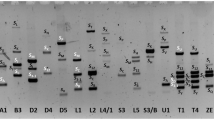Abstract
Popcorn (Zea mays L.) hybrids grown in the United States are derived from narrow-based germplasm, and standard RFLP analysis detects relatively little polymorphism. Inter-simple sequence repeat (ISSR) amplification, a novel technique based on PCR amplification of inter-microsatellite sequences to target multiple loci in the genome, was employed to investigate its potential for detection of polymorphism among nineteen popcorn and eight dent corn inbred lines. ISSR yielded an average of 54 bands/primer/inbred line, with over 98% of the bands repeatable across DNA extractions and separate PCR runs. Ten primers based on di- and tri-nucleotide tandem repeats revealed 73% and 87% polymorphism among popcorn and dent corn lines, respectively, with an overall 95% polymorphism rate. Principal component and cluster analyses resulted in grouping of dent and popcorn lines corresponding to their heterotic breeding pools. ISSR amplification, in addition to being both simple and cost and time efficient, provides for rapid production of highly polymorphic markers which appear to correspond to known pedigree information. Therefore, the ISSR technique may have great potential for identifying polymorphism in species with narrow-based germplasm, and for use in DNA marker-assisted breeding approaches.
Similar content being viewed by others
References
Akkaya MS, Bhagwat AA, Cregan PB: Length polymorphisms of simple sequence repeat DNA in soybean. Genetics 132: 1131–1139 (1992).
Condit R, Hubbel SP: Abundance and DNA sequence of two-base repeat regions in tropical tree genomes. Genome 34: 66–71 (1991).
Dudley JW, Saghai Maroof MA, Rufener GK: Molecular markers and grouping of parents in maize breeding programs. Crop Sci 31: 718–723 (1991).
Dunn G, Everitt BS: An Introduction to Mathematical Taxonomy. Cambridge University Press, Cambridge (1982).
Ellsworth DL, Rittenhouse KD, Honeycutt RL: Artifactual variation in randomly amplified polymorphic DNA banding patterns. Biotechniques 14: 214–217 (1993).
Gower JC: A general coefficient of similarity and some of its properties. Biometrics 27: 857–874 (1971).
Gupta M, Chyi Y-S, Romero-Severson J, Owen JL: Amplification of DNA markers from evolutionarily diverse genomes using single primers of simple-sequence repeats. Theor Appl Genet 89: 998–1006 (1994).
Hallauer AR, Russel WA, Lamkey KR: Corn breeding: In Sprague GF, Dudley JW (Eds), Corn and Corn Improvement, pp. 469–564. Agronomy monograph 18, American Society of Agronomy, Madison, WI (1988).
Halward T, Stalker T, LaRue E, Kochert G: Use of single primer DNA amplifications in genetic studies of peanut (Arachis hypogaea L.). Plant Mol Biol 18: 315–325 (1992).
Hamada H, Petrino MG, Kakunaga T: A novel repeat element with Z-DNA-forming potential is widely found in evolutionarily diverse eukaryotic genomes. Proc Natl Acad Sci USA. 79: 6465–6469 (1982).
Lagercrantz U, Ellegren H, Andersson L: The abundance of various polymorphic microsatellite motifs differs between plants and vertebrates. Nucleic Acids Res 21: 1111–1115 (1993).
Melchinger AE, Messmer MM, Lee M, Woodman WL, Lamkey KR: Diversity and relationships among U.S. maize inbreds revealed by restriction fragment length polymorphisms. Crop Sci. 31: 669–678 (1991).
Micheli MR, Bova R, Pascale E, D'Ambrosio E: Reproducible DNA fingerprinting with the random amplified polymorphic DNA (RAPD) method. Nucleic Acids Res 22: 1921–1922 (1994).
Mumm RH, Dudley JW: A classification of 148 U.S. maize inbreds. I. Cluster analysis based on RFLPs. Crop Sci 34: 842–851 (1994).
Mumm RH, Dudley JW: A PC SAS computer program to generate a dissimilarity matrix for cluster analysis. Crop Sci 35: 925–927 (1995).
Muralidharan K, Wakeland EK: Concentration of primer and template qualitatively affects products in randomamplified polymorphic DNA PCR. Biotechniques 14: 362–364 (1993).
Rafalski AJ, Tingey SV: Genetic diagnostics in plant breeding: RAPDs, microsatellites and machines. Trends Genet 9: 275–279 (1993).
Riedy MF, Hamilton III WJ, Aquadro CF: Excess of non-parental bands in offspring from known primate pedigrees assayed using RAPD PCR. Nucleic Acids Res 20: 918 (1992).
Saghai-Maroof MA, Soliman KM, Jorgensen RA, Allard RW: Ribosomal DNA spacer-length polymorphisms in barley: Mendelian inheritance, chromosomal location, and population dynamics. Proc Natl Acad Sci USA 81: 8014–8018 (1984).
Salimath SS, Oliveira AC, Godwin ID, Bennetzen JL: Assessment of genome origins and genetic diversity in the genusEleusine with DNA markers. Genome 38: 757–763 (1995).
SAS Institute Inc: SAS/STAT User's Guide, version 6, SAS Institute, Cary (1989).
Scroch P, Tivang J, Nienhuis J: Analysis of genetic relationships using RAPD marker data. In: Proceedings of the Applications of RAPD technology to Plant Breeding, Minneapolis, MN, pp. 26–30. Crop Science Society of America, Madison, WI (1992).
Smith OS, Smith JCS, Bowen SL, Tenborg RA, Wall SJ: Similarities among a group of elite maize inbreds as measured by pedigree, F1 grain yield, grain yield, heterosis, and RFLPs. Theor Appl Genet 80: 833–840 (1990).
Tanksley SD: Molecular markers in plant breeding. Plant Mol Biol Rep 1: 3–8 (1983).
Wu K-S, Tanksley SD: Abundance, polymorphism and genetic mapping of microsatellites in rice. Mol Gen Genet 241: 225–235 (1993).
Ziegler K, Ashman B: Popcorn. In Hallauer AR (Ed), Specialty Corns, pp. 189–224 CRC Press Inc, Boca Raton, FL (1994).
Zietkiewicz E, Rafalski A, Labuda D: Genome fingerprinting by simple sequence repeat (SSR)-anchored polymerase chain reaction amplification. Genomics 20: 176–183 (1994).
Author information
Authors and Affiliations
Rights and permissions
About this article
Cite this article
Kantety, R.V., Zeng, X., Bennetzen, J.L. et al. Assessment of genetic diversity in dent and popcorn (Zea mays L.) inbred lines using inter-simple sequence repeat (ISSR) amplification. Mol Breeding 1, 365–373 (1995). https://doi.org/10.1007/BF01248414
Received:
Accepted:
Issue Date:
DOI: https://doi.org/10.1007/BF01248414




